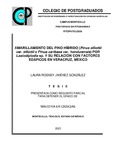| dc.description.abstract | El establecimiento de las plantaciones forestales comerciales en Veracruz puede verse influenciada negativamente por diversos factores, entre los que destacan, el clima, la calidad del suelo y las enfermedades. El objetivo de la presente investigación fue determinar la etiología del amarillamiento de árboles de pino híbrido y su relación con las propiedades físicas, químicas y biológicas del suelo. En diciembre de 2018, en las plantaciones forestales comerciales del sur de Veracruz, se colectaron muestras de raíz y tallo de árboles con amarillamiento y muestras asintomáticas para el aislamiento de hongos fitopatógenos. En agosto 2019, se colectaron 85 muestras de suelo de 500g c/u a 30 cm de profundidad, para la determinación nutrimental del suelo, los cuales se realizaron en GISENAlabs Texcoco, Edo. de México, bajo la metodología interna del Laboratorio y la NOM-021-RECNAT-2000. Del mismo modo, de árboles con amarillamiento, en seis lotes de aproximadamente una hectárea cada una, se colectaron 36 muestras de suelo de 200 g c/u, para el análisis de la diversidad fúngica, lo cual se realizó en el laboratorio de Patología Forestal del COLPOS al igual que el manejo de las muestras de tejido vegetal. Estas últimas se sembraron en cajas Petri con medio de cultivo papa-dextrosa-agar (PDA) y se incubaron a 28±2 °C. Para diversidad fúngica, se utilizó medio PDA-TS (Papa – Dextrosa – Agar- Tergitol – Estreptomicina) de Steiner y Watson (1965). De los árboles muestreados, se aisló el hongo Lasiodiplodia sp. proveniente del tallo, generando una asociación hospedante-patógeno del 34.6%, de la cual, el 24.6% se aislaron de muestras con amarillamiento, mientras que el 10% restante se aisló de árboles asintomáticos. Mediante análisis filogenético de la región ITS, los genes β-tubulina (β-tub) y factor de elongación 1-alfa (TEF1-α), se identificaron las especies Lasiodiplodia theobromae, L. brasiliense y L. iraniensis. Por su prevalencia y asociación constante con los síntomas bajo estudio, la cepa L. theobromae se seleccionó para la prueba de patogenicidad y cuatro días después de la inoculación se presentaron los síntomas típicos de amarillamiento y muerte de plántulas. Los resultados de las variables de suelo indican bajos niveles de materia orgánica, pH de ácidos a fuertemente ácido, con baja disponibilidad de N, P, K, analizados de acuerdo a la norma 021. Los hongos del suelo identificados fueron Aspergillus, Penicillium, Trichoderma y Fusarium. De acuerdo al índice de Shannon-Weaver la diversidad fúngica es baja, lo cual se relaciona con niveles bajos de materia orgánica y poca disponibilidad de nutrimentos. De acuerdo a los resultados se concluye que Lasiodiplodia theobromae está estrechamente relacionado con la baja calidad del suelo misma que afecta el desarrollo de los árboles sometiéndolas a estrés constante, condición que originó el desarrollo del hongo. _______________ YELLOWING OF THE HYBRID PINE (Pinus elliottii var. elliottii x Pinus caribaea var. hondurensis) FOR Lasiodiplodia sp. AND ITS RELATIONSHIP WITH EDAPHIC FACTORS IN VERACRUZ, MEXICO. ABSTRACT: The establishment of commercial forest plantations in Veracruz can be negatively influenced by several factors, including climate, soil quality and diseases. The main goal of this research was to determine the etiology of the yellowing of hybrid pine tree and their relationship with the physical, chemical and biological properties of the soil. In december 2018, root and stem samples of trees with yellowing and asymptomatic samples were collected in the commercial forest plantations in south of Veracruz, for the isolation of phytopathogenic fungi. In august 2019, 85 soil samples of 500 g each to were collected at a depth of 30 cm, for soil analysis, which were carried out at GISENAlabs Texcoco, State of Mexico under the methodology of the Laboratory and the NOM-021-RECNAT-2000. Also, from yellowing trees, in six plots of approximately one hectare each, 36 soil samples of 200 g each were collected for fungal diversity analysis, carried out in the Forest Pathology laboratory of COLPOS as well as plant tissue samples processing. The latter were seeded in Petri dishes with potato-dextrose-agar (PDA) culture medium and incubated at 28±2 °C. For fungal diversity analysis, PDA-TS medium (Potato - Dextrose - Agar - Tergitol - Streptomycin) by Steiner and Watson (1965) was used. Of the trees sampled, the fungus Lasiodiplodia sp. was isolated from the stem, generating a host/pathogenic association of 34.6%, of which 24.6% were isolated from samples with yellowing, while the remaining 10% were isolated from asymptomatic trees. Through phylogenetic analysis of ITS region, β-tubulin (β-tub) and 1-alpha elongation factor (TEF1-α) genes, the species Lasiodiplodia theobromae, L. brasiliense and L. iraniensis were identified. Because of its prevalence and constant association with the symptoms under study, the L. theobromae strain was selected for the pathogenicity test and four days after inoculation the typical symptoms of yellowing and seedling death occurred. The results of the soil variables indicate low levels of organic matter, acidic and strongly acidic pH's, with low availability of N, P, K, analyzed according to standard 021. The soil fungi identified were Aspergillus, Penicillium, Trichoderma and Fusarium. According to the Shannon-Weaver index the fungal diversity is low which is related to low levels of organic matter and low nutrients availability. According to the results, it is concluded that Lasiodiplodia theobromae is closely related to the low quality of the soil itself, which affects the development of trees by predisposing them to constant stress, a condition that originates the development of the fungus. | es_MX |


